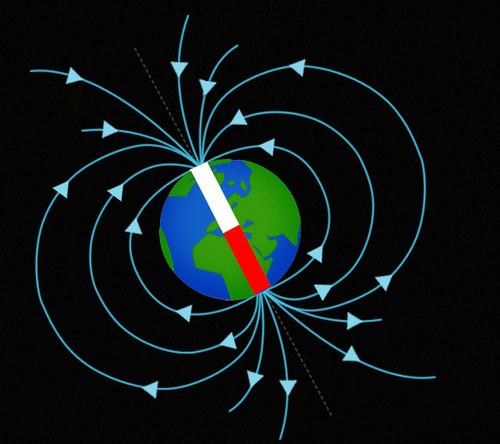What is Earth’s Magnetic Field (E M F)?
Our planet, Earth, is surrounded by a mysterious force that plays a crucial role in shaping our environment—the magnetic field. In this article, we will delve into the intricacies of Earth’s magnetic field, exploring its origins, functions, and the impact it has on our daily lives.

Table of Contents
Introduction
Earth’s magnetic field is a complex phenomenon that has fascinated scientists for centuries. It is an invisible force that extends from the Earth’s interior into space, influencing various aspects of our planet. Understanding this magnetic field is not only a matter of scientific curiosity but also a practical necessity.
What is Earth’s Magnetic Field?
Earth’s magnetic field is a complex and dynamic force that surrounds our planet. It is generated by the movement of molten iron and nickel in the Earth’s outer core. This movement, driven by heat escaping from the Earth’s interior, creates electric currents, which in turn produce magnetic fields. The collective effect of these magnetic fields results in the overall magnetic field that surrounds the Earth.
The Earth’s magnetic field has both a north and a south pole, much like a bar magnet. However, the magnetic poles are not aligned with the geographic poles (the points where the Earth’s axis of rotation intersects its surface). The magnetic poles are subject to gradual movement and can shift over time.
This magnetic field plays a crucial role in protecting the Earth from the solar wind, a stream of charged particles constantly emitted by the Sun. The magnetosphere, formed by the interaction between the solar wind and the Earth’s magnetic field, helps shield the planet’s atmosphere from the solar wind’s erosive effects.
Additionally, Earth’s magnetic field has practical implications, as it serves as a reference for navigation, with compass needles aligning along the magnetic field lines. The study of the Earth’s magnetic field has also contributed to our understanding of the planet’s interior and its geodynamic processes.
How Does Earth’s Magnetic Field Work?
Earth’s magnetic field is generated by the movement of molten iron and nickel in the outer core of the Earth. This process is driven by the heat released from the Earth’s interior, primarily due to the decay of radioactive isotopes and the residual heat from the planet’s formation.
The key components of how Earth’s magnetic field works are as follows:
- Outer Core Convection:
- The outer core of the Earth, located beneath the solid mantle, is composed mostly of molten iron and nickel. This material is in constant motion due to heat-driven convection currents.
- As the molten iron and nickel move, they generate electric currents. This movement of electrically conductive fluid in the outer core is crucial for the generation of the magnetic field.
- Dynamo Effect:
- The movement of the molten iron and nickel in the outer core, combined with the Earth’s rotation, induces the geodynamo effect. This effect is a self-sustaining process where the motion of the electrically conductive fluid generates a magnetic field.
- The Coriolis effect, resulting from the Earth’s rotation, causes the fluid motion to organize into large-scale, swirling convection currents that amplify the magnetic field.
- Magnetic Field Generation:
- The electric currents generated in the outer core produce magnetic fields according to Ampère’s law. These magnetic fields combine to create a complex and dynamic overall magnetic field around the Earth.
- The Earth’s magnetic field has both a north and a south pole, similar to a bar magnet. However, unlike a simple bar magnet, the Earth’s magnetic field is constantly changing and adapting to the dynamic processes occurring in the outer core.
- Geomagnetic Polarity and Reversals:
- Over geological time scales, the Earth’s magnetic field undergoes polarity reversals, during which the magnetic north and south poles switch places.
- The causes of these reversals are not fully understood, but they are thought to be related to changes in the flow patterns of the molten iron and nickel in the outer core.
Magnetic Poles and the Geographic Poles
The Earth has two sets of poles: magnetic poles and geographic poles. These poles serve different purposes and are located in different positions on the planet.
- Magnetic Poles:
- The magnetic poles are the points on the Earth’s surface where the planet’s magnetic field lines converge and enter or emerge from the Earth. These poles are not fixed and can move over time due to changes in the Earth’s magnetic field.
- As of my knowledge cutoff in January 2022, the magnetic North Pole was located in the Arctic region of Canada and was drifting northwest at a rate of several kilometers per year. The magnetic South Pole was situated in the Antarctic region.
- The magnetic poles are not aligned with the geographic poles and do not correspond to the Earth’s axis of rotation.
- Geographic Poles:
- The geographic poles are the points where the Earth’s axis of rotation intersects its surface. There are two geographic poles: the North Pole and the South Pole.
- The North Pole is situated in the Arctic region, while the South Pole is located in Antarctica. Unlike the magnetic poles, the geographic poles are fixed and do not move.
- The Earth’s axis of rotation connects the North Pole and the South Pole, and it remains relatively stable in its orientation.
It’s important to note that the magnetic and geographic poles do not coincide. The angle between the geographic and magnetic poles is called magnetic declination, and it varies depending on the location on the Earth’s surface. Navigational tools, such as compasses, take into account this declination to provide accurate navigation based on magnetic directions.
The interaction between the Earth’s magnetic field and the geographic poles is essential for various natural processes, including the formation of the magnetosphere, which helps shield the Earth from the solar wind and cosmic radiation. Additionally, understanding the dynamics of the magnetic poles is crucial for navigation and scientific studies of the Earth’s interior and geophysical processes.
Importance to Earth and Life
The Earth’s magnetic field plays a crucial role in protecting the planet and sustaining life as we know it. One of its primary functions is shielding the Earth from the solar wind, a continuous stream of charged particles emitted by the Sun. The magnetosphere, formed by the interaction between the solar wind and the Earth’s magnetic field, acts as a protective barrier that prevents the solar wind from stripping away the atmosphere and water vapor.
This preservation of the atmosphere is essential for maintaining stable temperatures and pressure, which are vital for supporting life. Additionally, the magnetic field aids in navigation, with compass needles aligning along its lines. This has been instrumental for human exploration and trade throughout history.
Furthermore, the study of Earth’s magnetic field provides valuable insights into the planet’s interior structure and geodynamic processes, contributing to our understanding of Earth’s evolution. In summary, the Earth’s magnetic field is not only a fundamental aspect of our planet’s physical dynamics but also a key factor in creating and sustaining the conditions necessary for life.
Variations and Anomalies
The Earth’s magnetic field is not uniform and exhibits variations and anomalies across its surface. Magnetic variations refer to changes in the strength and direction of the magnetic field at different locations on the Earth. These variations can be influenced by geological features, such as variations in the composition and magnetization of rocks in the Earth’s crust. Anomalies, on the other hand, are localized deviations from the expected or average magnetic field strength in a particular region.
One notable example is the magnetic declination, the angle between the geographic and magnetic poles, which varies depending on the location. This information is crucial for accurate navigation using magnetic compasses. Magnetic anomalies, often caused by variations in the Earth’s crustal composition or by the presence of mineral deposits, can be identified through magnetic surveys and are valuable in geological exploration.
Another phenomenon is secular variation, representing the long-term changes in the Earth’s magnetic field. The positions of the magnetic poles can shift over time, and the overall strength of the magnetic field can undergo gradual changes. Additionally, there are rapid changes known as geomagnetic jerks, sudden shifts in the Earth’s magnetic field that occur over a short period.
Understanding these variations and anomalies is vital for various applications, including navigation, satellite systems, and geological exploration. Researchers monitor and study these changes to gain insights into the Earth’s interior dynamics and the processes occurring in the outer core, contributing to our broader understanding of the Earth’s geophysical behavior.
Measurement and Mapping
Measurement and mapping of the Earth’s magnetic field are crucial for various scientific, navigational, and geological applications. To measure the Earth’s magnetic field, scientists use instruments known as magnetometers. These devices can detect the strength and direction of the magnetic field at a specific location. There are various types of magnetometers, including fluxgate magnetometers, proton precession magnetometers, and Overhauser magnetometers, each with its own advantages and applications.
Magnetic field measurements contribute to the creation of magnetic maps, which display the distribution of magnetic field strength and direction across different regions. These maps are essential for navigation, as they help correct for magnetic declination, allowing for accurate use of magnetic compasses. They are also valuable in geological studies, as variations in the magnetic field can provide information about the composition and structure of the Earth’s crust. Geophysicists use magnetic surveys to identify anomalies that may indicate the presence of mineral deposits or geological features.
Satellites equipped with magnetometers contribute to global magnetic mapping. Satellites such as the European Space Agency’s Swarm mission and NASA’s Magnetospheric Multiscale (MMS) mission provide comprehensive data on the Earth’s magnetic field from space, offering a more extensive and detailed view.
Mapping the Earth’s magnetic field aids in monitoring changes over time, such as secular variation and rapid changes like geomagnetic jerks. Understanding these changes is essential for maintaining accurate navigation systems, predicting space weather effects on technology, and gaining insights into the Earth’s dynamic processes.

Human Interaction with Earth’s Magnetic Field
Humans interact with Earth’s magnetic field in various ways, and this interaction has practical, technological, and biological implications.
- Navigation:
- One of the most significant ways humans interact with Earth’s magnetic field is through navigation. Magnetic compasses, which align with the magnetic field lines, have been used for centuries for navigation at sea and on land. They provide a reliable reference for determining directions, aiding explorers, sailors, and travelers.
- Technology and Electronics:
- Modern technology relies on an understanding of Earth’s magnetic field. Electronic devices, such as smartphones and tablets, often include magnetometers for functions like compass applications. Magnetic sensors in technology contribute to determining device orientation and enable features like automatic screen rotation.
- Geomagnetic Storms and Space Weather:
- Earth’s magnetic field plays a crucial role in shielding the planet from solar wind and charged particles from the Sun. Geomagnetic storms, caused by disturbances in the solar wind, can impact power grids, satellite communications, and navigation systems. Understanding and monitoring Earth’s magnetic field are essential for mitigating potential effects of space weather on human technology.
- Health and Biological Navigation:
- Some research suggests that certain animals, including some birds, bees, and sea turtles, may use Earth’s magnetic field for navigation during migration. While humans don’t have this innate ability, there is ongoing research on the potential influence of geomagnetic fields on human health and behavior. However, the exact mechanisms and impacts are still areas of investigation.
- Scientific Exploration:
- Scientists and researchers use measurements of Earth’s magnetic field for various purposes, such as studying the Earth’s interior, identifying geological structures, and understanding changes in the magnetic field over time. Magnetic surveys are common tools in geophysics and exploration for natural resources.
- Magnetic Resonance Imaging (MRI):
- In medical applications, humans indirectly interact with magnetic fields during MRI scans. MRI machines use strong magnetic fields and radio waves to create detailed images of the internal structures of the human body.
While humans don’t have a direct sensory perception of Earth’s magnetic field, our technological advancements and scientific understanding of this natural phenomenon have led to numerous applications that impact various aspects of our lives. The dynamic interplay between humans and Earth’s magnetic field continues to be an area of exploration and research across different disciplines.
Magnetic Field Reversals
Magnetic field reversals, also known as geomagnetic reversals, are intriguing phenomena in which the Earth’s magnetic field undergoes a gradual and significant change, leading to a reversal of the magnetic poles. Instead of having the magnetic north pole near the geographic North Pole, it temporarily switches to the geographic South Pole, and vice versa. These reversals are not regular events and occur over geological timescales, with intervals ranging from hundreds of thousands to millions of years.
Scientists have gained insights into magnetic field reversals through the study of paleomagnetism, examining the magnetic signatures preserved in rocks and sediments. Magnetic minerals in these materials align with the prevailing magnetic field during their formation, creating a historical record that reveals periods of normal and reversed polarity.
While the exact mechanisms driving magnetic field reversals are not fully understood, researchers believe that changes in the flow patterns of molten iron and nickel in the Earth’s outer core, coupled with the planet’s rotation, play a significant role. The process is thought to be complex and may involve interactions between fluid dynamics, magnetic induction, and other geophysical factors.

During a magnetic field reversal, the strength of the magnetic field may decrease, leading to a temporary weakening of the Earth’s protective magnetosphere. This weakening could potentially impact technologies that rely on the stability of the magnetic field, such as navigation systems. However, the effects on life are generally considered minimal, as the reversal process occurs over thousands of years.
The last magnetic field reversal, known as the Brunhes- Matuyama reversal, occurred approximately 780,000 years ago. The Earth is currently in a period of normal polarity, with the magnetic north pole near the geographic North Pole. Continued research into magnetic field reversals contributes to our understanding of the Earth’s internal dynamics and the intricate processes occurring in its outer core.
Future Predictions and Research
Ongoing research endeavors aim to unravel the mysteries of Earth’s magnetic field further. Predictions about future changes and technological advancements are at the forefront of scientific exploration.
Common Misconceptions
Dispelling myths surrounding E M F is essential. Addressing misconceptions about its supposed health effects and demystifying the true nature of this force contribute to a more informed public understanding.
The Auroras: Nature’s Light Show
A captivating connection exists between Earth’s magnetic field and the mesmerizing auroras. Understanding the geographic regions where auroras are most visible adds a celestial dimension to the appreciation of our planet’s magnetic charm.
Earth’s Magnetic Field in Popular Culture
Beyond its scientific significance, Earth’s magnetic field has permeated popular culture, influencing literature, movies, and art. Its presence in creative works reflects the enduring fascination with the enigmatic force that surrounds us.
Challenges in Studying Earth’s Magnetic Field
While advancements in technology have enhanced our understanding, challenges persist in studying Earth’s magnetic field. Overcoming these obstacles is crucial for future breakthroughs and a comprehensive grasp of this complex phenomenon.
Conclusion
In conclusion, E M F remains a captivating subject that intertwines science, technology, and the essence of our planet’s existence. From shielding us against solar winds to influencing the way we navigate, its significance is undeniable. As we continue to explore and understand this magnetic realm, the mysteries it holds promise to unlock new avenues of knowledge.
Check out the article. Click here
FAQs
- Is E M F constant, or does it change over time?
- E M F is not constant; it undergoes natural variations and can even experience complete reversals over geological time.
- How does E M F impact technology?
- E M F affects technology by influencing compasses, navigation systems, and even satellite communications.
- Can changes in E M F affect human health?
- Contrary to some misconceptions, changes in E M F do not have direct adverse effects on human health.
- What causes the phenomenon of auroras related to E M F?
- Auroras are a result of charged particles from the sun interacting with E M F, creating mesmerizing light displays.
- How do scientists study E M F?
- Scientists use various techniques, including magnetometers and satellite observations, to measure and study E M F.









